

Why I've lost faith in p values — Luck Lab. Critics of Evolutionary Psychology Say It’s All Just Storytelling. Here’s Why They’re Wrong. How One Psychologist Is Tackling Human Biases in Science. Sometimes it seems surprising that science functions at all.
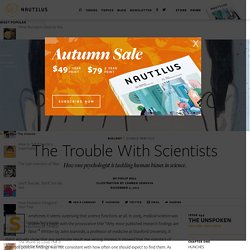
In 2005, medical science was shaken by a paper with the provocative title “Why most published research findings are false.”1 Written by John Ioannidis, a professor of medicine at Stanford University, it didn’t actually show that any particular result was wrong. Instead, it showed that the statistics of reported positive findings was not consistent with how often one should expect to find them.
As Ioannidis concluded more recently, “many published research findings are false or exaggerated, and an estimated 85 percent of research resources are wasted.”2 It’s likely that some researchers are consciously cherry-picking data to get their work published. And some of the problems surely lie with journal publication policies. The Unbearable Asymmetry of Bullshit - Quillette.
Science and medicine have done a lot for the world.

Diseases have been eradicated, rockets have been sent to the moon, and convincing, causal explanations have been given for a whole range of formerly inscrutable phenomena. Daryl Bem proved ESP is real. Which means science is broken. Richard Feynman Teaches you the Scientific Method. “If it disagrees with experiment, it’s wrong.
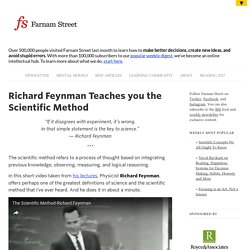
In that simple statement is the key to science.” — Richard Feynman The scientific method refers to a process of thought based on integrating previous knowledge, observing, measuring, and logical reasoning. Scientific theories aren't mere conjecture – to survive they must work. “The evidence is incontrovertible.
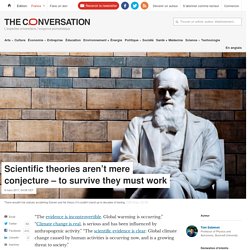
Global warming is occurring.” “Climate change is real, is serious and has been influenced by anthropogenic activity.” “The scientific evidence is clear: Global climate change caused by human activities is occurring now, and is a growing threat to society.” As these scientific societies’ position statements reflect, there is a clear scientific consensus on the reality of climate change. How the scientific method came from watching children play. There is a theory in psychology called the theory theory.

It’s a theory about theories. While this might sound obvious, the theory theory leads to counterintuitive conclusions. A quarter-century ago, psychologists began to point out important links between the development of scientific theories and how everyday thinking, including children’s thinking, works. According to theory theorists, a child learns by constructing a theory of the world and testing it against experience. When Big Ideas Go Bad - The Chronicle of Higher Education. Amy Cuddy’s TED talk on power poses has been viewed 37 million times.
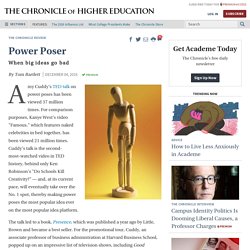
It’s time for science to abandon the term ‘statistically significant’ The aim of science is to establish facts, as accurately as possible.
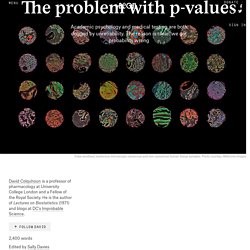
It is therefore crucially important to determine whether an observed phenomenon is real, or whether it’s the result of pure chance. If you declare that you’ve discovered something when in fact it’s just random, that’s called a false discovery or a false positive. And false positives are alarmingly common in some areas of medical science. In 2005, the epidemiologist John Ioannidis at Stanford caused a storm when he wrote the paper ‘Why Most Published Research Findings Are False’, focusing on results in certain areas of biomedicine. The Problem With Science Writing. Want to hear a seamy insider secret from the science communication industry?

The border between journalism and public relations has more turnstiles than Grand Central. Professionals move with relative ease, and little stigma, between newspapers, websites, and magazines and what would otherwise be called propaganda centers—university communication departments, government agencies, corporate PR arms, military research branches, and so on. Paul Feyerabend’s defense of astrology, part I. Paul Feyerabend was the enfant terrible of 1960s philosophy of science.
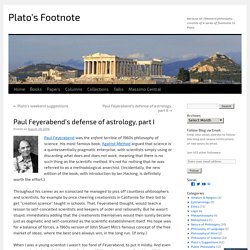
His most famous book, Against Method argued that science is a quintessentially pragmatic enterprise, with scientists simply using or discarding what does and does not work, meaning that there is no such thing as the scientific method. We Should Not Accept Scientific Results That Have Not Been Repeated. A few years ago, I became aware of serious problem in science: the irreproducibility crisis.
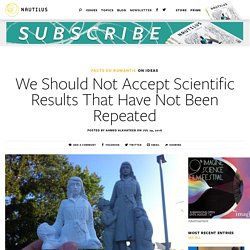
A group of researchers at Amgen, an American pharmaceutical company, attempted to replicate 53 landmark cancer discoveries in close collaboration with the authors. Many of these papers were published in high-impact journals and came from prestigious academic institutions. The Structure of Scientific Revolutions. Scientific Regress by William A. Wilson. The problem with science is that so much of it simply isn’t. Last summer, the Open Science Collaboration announced that it had tried to replicate one hundred published psychology experiments sampled from three of the most prestigious journals in the field.
Scientific claims rest on the idea that experiments repeated under nearly identical conditions ought to yield approximately the same results, but until very recently, very few had bothered to check in a systematic way whether this was actually the case. The OSC was the biggest attempt yet to check a field’s results, and the most shocking. In many cases, they had used original experimental materials, and sometimes even performed the experiments under the guidance of the original researchers. Of the studies that had originally reported positive results, an astonishing 65 percent failed to show statistical significance on replication, and many of the remainder showed greatly reduced effect sizes.
Scientific method: Statistical errors. For a brief moment in 2010, Matt Motyl was on the brink of scientific glory: he had discovered that extremists quite literally see the world in black and white. The results were “plain as day”, recalls Motyl, a psychology PhD student at the University of Virginia in Charlottesville. Theconversation. Research and creative thinking can change the world. This means that academics have enormous power. But, as academics Asit Biswas and Julian Kirchherr have warned, the overwhelming majority are not shaping today’s public debates. Instead, their work is largely sitting in academic journals that are read almost exclusively by their peers. Biswas and Kirchherr estimate that an average journal article is “read completely by no more than ten people”.
They write: Up to 1.5 million peer-reviewed articles are published annually. Karl Popper: What Makes a Theory Scientific. It’s not immediately clear, to the layman, what the essential difference is between science and something masquerading as science: pseudoscience. The distinction gets at the core of what comprises human knowledge: How do we actually know something to be true? Is it simply because our powers of observation tell us so? The Amazing Significo: why researchers need to understand poker. Nearly all of our medical research is wrong. Science and math dominate the contemporary educational landscape in the United States. Almost everyone agrees that the country needs to shape workers with the skills to combat global problems like climate change, cancer and ailing infrastructures.
Philosophers want to know why physicists believe theories they can’t prove. Almost no education research is replicated, new article shows. Science Isn’t Broken. ‘Open Science’ Challenges Journal Tradition With Web Collaboration. For centuries, this is how science has operated — through research done in private, then submitted to science and medical journals to be reviewed by peers and published for the benefit of other researchers and the public at large. We Paid for the Scientific Research, So Let’s See It. The agencies must submit plans to the White House Office of Science and Technology Policy within the next six months that will apply to both peer-reviewed scientific papers and digital manuscripts and supporting data. Academia.edu - Share research.
The Story Behind a Radical New Idea: A Social Network for Academia. Richard Price, the founder of Academia.edu, a social network for academic researchers, recently raised $11.1 million in a Series B funding round. ResearchGate. Crowdfunding propels scientific research. Grow the next generation of ideas. Crowdfunded science projects site launches. Fund me, please. Solve For X. Steps of the Scientific Method - The Stages of Scientific Research. Scientific Method Graphic. A little knowledge: The significance of expertise passed on by direct contact. Why We Can’t Rule Out Bigfoot - Issue 16: Nothingness. Sir Karl Popper's "Science as Falsification" What the Pope Teaches Us About the Scientific Method. Other-texts/popper-logic-scientific-discovery.pdf. Rupert Sheldrake - The Science Delusion BANNED TED TALK.
The Rise and Fall of Militant Skepticism (Part 4) The Two Faces Of Science : 13.7: Cosmos And Culture. Citation Bias – Confirmation Bias for Scientists. Study: Fraud growing in scientific research papers. "Get Me Off Your Fucking Mailing List" is an actual science paper accepted by a journal. How Many Psychology Studies Are Wrong? Fraud and Errors in Scientific Studies Skyrocket. Singularity: Kurzweil on 2045, When Humans, Machines Merge. Tests of Parents Are Used to Map Genes of a Fetus. I Point To TED Talks and I Point to Kim Kardashian. That Is All. Science in Society.